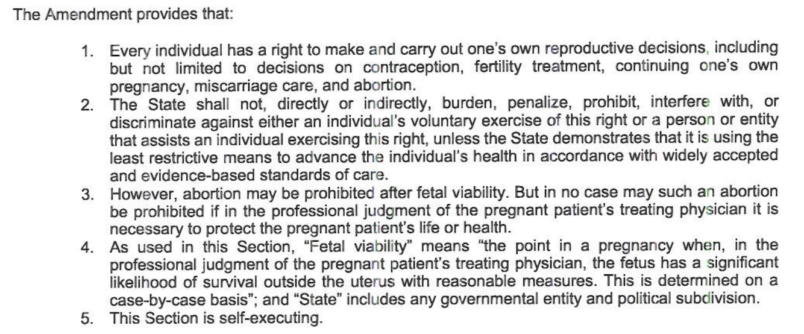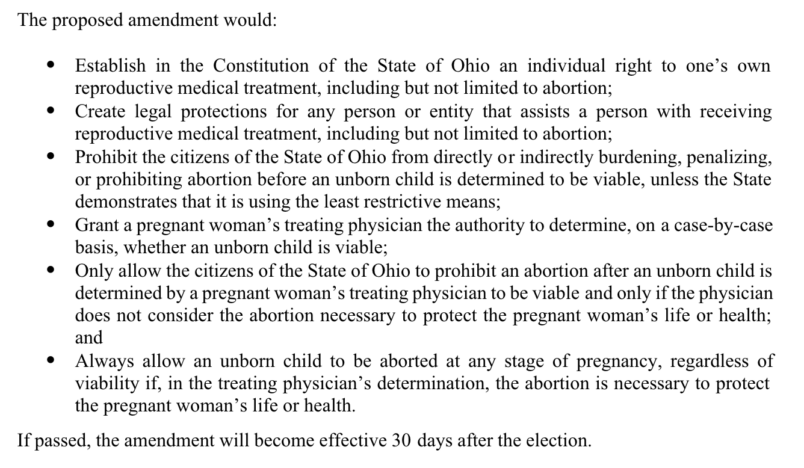Supporters of the major upcoming Ohio abortion amendment, which would enshrine a right to the procedure in the state’s constitution, thought they were out of the woods.
Earlier this month, they defeated a state Republican-led attempt to raise the threshold for citizen-initiated ballot proposals to 60 percent — which would have included the abortion one in November — in decisive fashion, despite the election being held in sleepy August.
But Republicans’ efforts to rig the game in their favor continues.
On Thursday, the Ohio Ballot Board approved a summary of the amendment text, which will appear on the ballots, that bears little resemblance to the full amendment. Ohio Secretary of State Frank LaRose (R) — a champion of the unsuccessful 60 percent threshold initiative, opponent of the abortion amendment and 2024 U.S. Senate candidate — provided the swing vote to approve the summary.
He also revealed that he had a hand in crafting the new summary, saying that “having worked extensively on drafting this, I do believe it’s fair and accurate.”
Advocates of the amendment had pushed for having its full text appear on the ballot. LaRose shot that down, responding that the full amendment would be available on posters at voting locations, per the Ohio Capital Journal.
“They know that they have to put their thumb — and all their fingers, and their elbows and knees — on their side of the scale to make it as biased as possible in order to have any chance at winning,” Ohio Rep. Elliot Forhan (D), a member of the ballot board, told TPM.
“It goes to the bigger picture of why are we here at all — because we have a democracy in the state of Ohio that is not reflective of the will of the voters,” he added, pointing to the state’s aggressive gerrymandering, along with a lack of campaign finance regulations and transparency measures.


The new summary sprinkles the anti-abortion phrase “unborn child” throughout, substituting it for “fetus.” It erases all mention of giving people the right to make decisions about their miscarriages, fertility treatments and contraception. Critics have called it “confusing” and “misleading.”
In the original version, the crux of the amendment reads: “The State shall not, directly or indirectly, burden, penalize, prohibit, interfere with, or discriminate against either an individual’s voluntary exercise of this right or a person or entity that assists an individual exercising this right, unless the State demonstrates that it is using the least restrictive means to advance this individual’s health in accordance with widely accepted and evidence-based standards of care.”
In the new version, that section becomes: “Prohibit the citizens of the State of Ohio from directly or indirectly burdening, penalizing, or prohibiting abortion before an unborn child is determined to be viable, unless the State demonstrates that it is using the least restrictive means.”
“The ballot language is longer than the amendment it purports to summarize and is needlessly repetitive,” Forhan said at the Thursday meeting. “It’s an attempt to confuse voters.”
State Sen. Paula Hicks-Hudson (D), the other Democrat on the board, made multiple attempts to sub in the old language for the new, but was outnumbered, per the Ohio Capital Journal.
Forhan pointed out to TPM the ludicrousness of only having the full text of the amendment available outside of the ballot booth.
“So they get their ballot from the poll worker at the front of the polling location, look at it, say ‘what the heck is this about,’ leave the booth and walk over to the wall to look?” he asked incredulously.
Lauren Blauvelt, Vice President of Government Affairs & Public Policy at Planned Parenthood Southwest Ohio Region, suggested after the board vote that the group campaigning for the abortion amendment may file a lawsuit in response.
Ohioans United for Reproductive Rights, the umbrella organization advocating for the amendment, did not immediately respond to TPM’s questions about its next steps.
“I do expect the petitioners to sue the ballot board,” Forhan said. “I’m looking forward to getting sued,” he added, laughing.
The Ohio Supreme Court became much more conservative in the 2022 election, casting doubt on how fair a hearing the abortion rights advocates would get there.
Forhan thinks the abortion rights groups have a good chance on some of the straightforward factual inaccuracies, like prohibiting the “citizens of the state of Ohio” from penalizing abortion versus the state itself. But on the nakedly anti-abortion language, it’s more of a tossup.
“Look, most voters will already know what they’re gonna do,” he said of the moment when voters enter the booth. “But not all of them.”



